Fujifilm X100T Review
Fujifilm X100T Introduction
The Fuji X100T is a premium compact camera with a large APS-C CMOS sensor and a specially designed Fujinon 23mm F/2 prime lens, equivalent to 35mm on a full-frame camera. This moderately compact camera offers a 16 megapixels X-Trans II CMOS sensor which is claimed to offer image-quality which compares to full-frame DSLRs.
The X-Trans II sensor offers a unique arrangement of color-filters which avoids moire even in the absence of an anti-alias filter. This second generation sensor includes built-in phase-detect autofocus. It is paired with dual mechanical and electronic shutters which now reach a maximum 1/32000s shutter-speed. Its unique hybrid viewfinder switches quickly between EVF and OVF modes and now features a unique digital overlay that super-imposes a portion of the EVF over the OVF.
The design of the Fuji X100T follows analog range-finders with direct dials to control exposure and a boxy metal construction. Automatic, semi-automatic and manual operations are all possible with this digital camera.
A leaf shutter is part of the lens which lets it sync with the flash at high-speed. Even more flexibility is provided by a built-in 3-stop ND filter.
This camera review takes a close look at the Fuji Finepix X100T in terms of features, its ergonomics, usability, performance and image quality.
Fuji Finepix X100T Features
Sensor
- 16 Megapixels APS-C X-Trans II CMOS sensor
- No Anti-Alias-Filter, 6x6 Color-Filter Array
- Built-in Phase-Detect autofocus
- ISO 200-6400 range, 1/3 EV steps
- Expanded ISO 100-25600 range
- Customizable Auto ISO
- JPEG, RAW or JPEG+RAW Output
- 1920x1080 @ 30 FPS 16:9 HD Video
Lens
- Fujinon 23mm, equivalent to 35mm
- Bright F/2 maximum 9-blade aperture
- F/2 - F/16 Aperture range, 1/3 EV steps
- Leaf-Shutter
- 10cm-2m Macro focus range
- 80cm Normal minimum focus distance
- Depth-Of-Field preview
- Optional 3-Stop ND-Filter
Exposure
- PASM Exposure modes
- 1/32000s-30s Shutter-speeds
- Bulb exposures up to 1 hour
- Exposure-Compensation, ±3 EV, 1/3 EV steps
- Flash-Compensation, ±2/3, 1/3 EV steps
- Multi-Segment, Spot & Average metering
- AEB, 3 Frames, ±1 EV, 1/3 steps
- ISO Bracketing, ±1 EV, 1/3 steps
- Multiple Exposure, 2 frames
- Fixed 1/3 EV exposure steps
Images Parameters
- Automatic, Preset, Kelvin and Custom WB
- WB fine-tuning, 19-steps along 2-axis
- Film Simulation: Provia, Velvia, Astia, Classic Chrome, B&W, B&W+Red Filter, B&W+Green Filter, B&W+Blue Filter, Sepia
- 100-400% Automatic or Manual Dynamic-Range
- Adjustable color-saturation, 5 steps
- Adjustable sharpness, 5 steps
- Adjustable highlight-tone, 5 steps
- Adjustable shadow-tone, 5 steps
- Adjustable noise-reduction, 5 steps
- Film Simulation Bracketing, 3 frames
- Optional Long-Exposure Noise-Reduction
Focus & Drive
- Hybrid Phase-Detect & Contrast-Detect AF
- 49 Selectable AF areas
- Auto or single focus-point selection
- Single-shot, continuous or manual focus
- 2s & 10s Self-Timers
- 6 or 3 FPS Drive, Max 29 JPEG or 8 RAW
- Motion Panorama, 180° & 120° angle-of-view
- Digital Split-Image or Focus Peaking MF-Assist
- Optional AF-Assist lamp
Viewfinder & Displays
- Unique Hybrid Viewfinder
- EVF: 100% Coverage, 0.5X magnification, 2.4 MP
- OVF: Over 100% coverage with 90% guide, 0.5X magnification
- Digital Range-Finder OVF overlay
- Eye-Start sensor automatically switches between Hybrid-Viewfinder and LCD
- 3" LCD, 1 megapixel, 100% coverage
- Digital-Level, 1 axis, tilt only
- Manual-Focus and Depth-Of-Field guide
- Optional Status-Display on rear LCD
- Optional HUD overlay on OVF
Controls
- Direct 1/3-stop Aperture-ring
- Direct full-stop dial for Shutter-Speed
- Extra dial for 1/3 stop shutter-speed control
- Extra rocker for 1/3 stop aperture control
- Direct exposure-compensation dial
- Implicit Exposure-Mode based on dials
- Combined configurable AE-L/AF-L button
- Customizable Function button
- Fly-By-Wire manual focus ring
Body & Construction
- Solid magnesium body
- Metal tripod mount
- Built-in flash, 9m reach
- Hot-Shoe for external lighting
- Wired remote terminal
- 1080i HDMI output
- USB 2.0 connectivity
- SDXC memory card slot
- Proprietary Lithium-Ion battery
The X100T is nearly identical to the X100S which precedes it. Differences are highlighted in green. For more details, see the Fuji X100S review
Fujifilm X100S.
Fujifilm X100T Usability - How easy is it to use?
Starting with its ergonomics, the X100T is rather boxy. There is a slight bump for a grip that provides almost no purchase. What adds security though is that the design of the X00T requires both hands to operate. The shutter-release is flat on the top-plate. It is usable but certainly not as comfortable as one mounted on a slant. At the rear, the thumb naturally falls on a clickable control-dial, which replaces a rocker on the X100S. The dial itself rotates easily with minimal detents. With practice, you can get used to rest your thumb on the small empty area below and to the right.
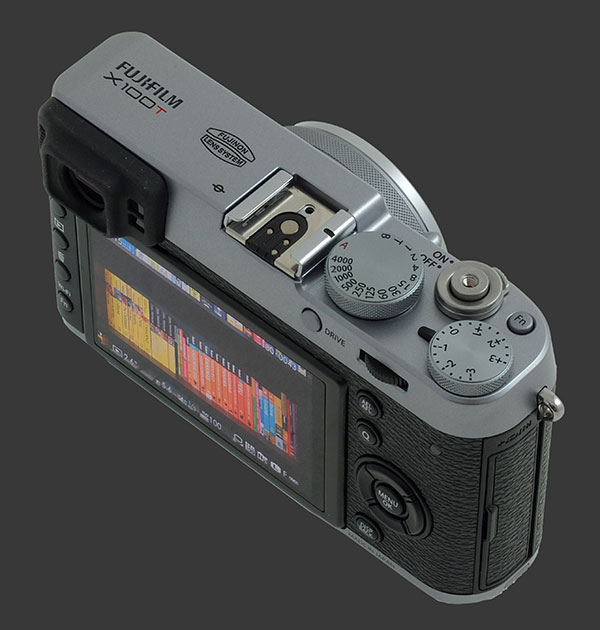
Along the left edge of the camera there is a column of seldom-used buttons. This is fortunate since the left hand is normally underneath the camera to reach the lens barrel. The lens protrudes less than 1" from the camera which keeps the whole package compact. The downside is that having both a focus and an aperture-ring around is tight. Fuji placed small tabs on opposite sides of the lens barrel to make it easier to turn but friction from while turning the ring never feels completely comfortable.
What feels great, on the left-side of the camera, is the viewfinder. The Fuji X100T is extremely comfortable to hold at eye-level as you can bring your eye very close without pressing your nose against it. Strangely, many cameras have done the opposite lately, moving the LCD to the left edge which makes smudge marks even more troubling. Kudos to Fuji for keeping the right thing to the left!
The Fuji X100T clearly has more direct controls than the vast majority of fixed-lens cameras. It is also highly modal, meaning that most dials have marked positions. This makes the camera-state readable by simply looking, even when it is off. This design makes the X100T more efficient to use than the majority of compacts. However, a number of oddities below show that this is not the case for everything.
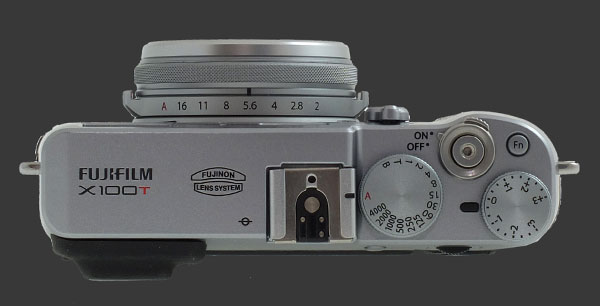
The aperture ring around the lens is labeled with full-stops from F/2 to F/16, plus an Automatic setting. There are actually 1/3-stop steps now but they are unlabeled. Detents between each 1/3-step are soft but inadvertent changes are unlikely because of the tabs which provide good purchase on the aperture-ring.
Setting shutter-speeds is more complex. There is a shutter-speed dial which sets full-stop increments from 1/4000s to 1/4s. For selecting shutter-speeds in smaller steps, turn the traditional dial which steps ±2/3 EV around the full-stop chosen by the top Shutter-Speed dial, plus shutter-speeds only available via the electronic-shutter: 1/4000s-1/32000s.
For slower shutter-speeds, the T position most be used. When in exclusive electronic-shutter mode, this fixes the shutter-speed to 1s. Otherwise, the rear dial can select shutter-speeds between 2s and 30s. The B position is for Bulb mode which works just as expected except when the aperture ring is at the A position. In that case, the camera always exposes for 30s at F/16.
Despite having 3 direct-controls to set 2 parameters, as described, there is no direct control for ISO, which one would expect from a camera with 3 control-dials! With the Fn button set to ISO, pressing it when not using the OVF makes the ISO menu appear which can be scrolled with the control-dial or the Up and Down buttons of the 4-way controller. With the OVF, a press of the Fn button when its assigned to ISO, allows the control-dial to select the sensitivity.
The last dial on the X100T is for Exposure-Compensation. It works universally and is completely predictable. Its state is reflected on a scale in the viewfinder. Steps are marked, so only 1/3 increments are available.
Absent from the Fuji X100T is an exposure mode-dial. With this camera, like the analog ones that inspired it, a photographer does not announce in advance which exposure parameters can be set. Instead, parameters are simply set to the desired value. If a parameter should be automatically controlled, then it is simply set to the A position. With two dials, this gives access to the four standard PASM mode:
| Exposure Mode | Aperture Ring | Shutter-Speed Dial | Control-Dial |
|---|---|---|---|
| Program | A | A | Program-Shift |
| Aperture-Priority | F/2 - F/16 | A | Unused |
| Shutter-Priority | A | 1/4000 - 1/4, T | ±2/3 EV, 1/32000 - 1/4000 |
| Manual | F/2 - F/16 | 1/4000 - 1/4, T, B | ±2/3 EV, 1/32000 - 1/4000 |
Focus modes are set using a slider on the left side of the camera. It is small and flush, so one can accidentally pass the middle setting easily. The bottom position if AF-S, while the top is MF. To set focus manually, a fly-by-wire ring at the front of the lens-barrel is used. It responds quickly and adjusts focus with a reasonable throw. The EVF is sufficiently precise to see what is in focus even without magnification. Pressing the control-dial inwards brings up MF-Assist which makes MF even easier. Incidently, this works even in Digital-Range Finder mode which magnifies its contents.
The 1 megapixel LCD on the rear measures 3" diagonally with a slightly-wider aspect-ratio than 3:2. It is bright with good visibility, an excellent viewing-angle and a very effective anti-reflection coating. This display has a good refresh rate too. The preview is vastly improved compared to the X100S. When no parameter is set to A, the preview is now Exposure-Priority when the Preview Exp In Manual Mode option is selected in the Setup menu. Otherwise, it still unfortunately shows the metered exposure, offset by EC, instead. Therefore, automatic and semi-automatic exposures are not previewed correctly.
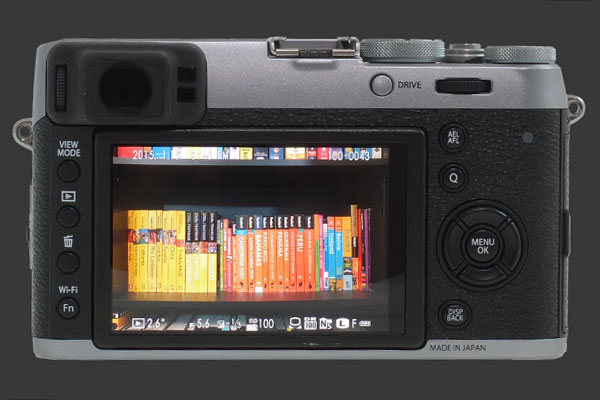
The unique hybrid viewfinder is a neat achievement. It combines an optical-tunnel viewfinder with an electronic one in the same space. In optical mode, the electronic components show an amazing HUD. Just like a typical optical-tunnel, the OVF shows neither focus, nor exposure, nor framing accurately. Framing is completely inaccurate. The view through the OVF shows considerable more than 100% while a frame within it supposedly marks a 92% coverage boundary. Because of alignment differences between the lens and OVF, the inner frame shifts after focusing, so reframing may be required. In practice, it does not shift enough so elements within the 92% boundary make in into the final image. Even after weeks of practice, accurately framing with the OVF is impossible.
The new feature in this hybrid EVF/OVF, is the Electronic Range-Finder. When enabled, part of the OVF is masked to show a portion of the EVF. There, the Fuji X100T shows the area in-focus, which can be magnified with MF-Assist, as described earlier. The portion covers about 1/16th of the OVF area and overlaps the lower-right corner of the bright-frame. This makes checking for unwanted elements in that part of the image impossible. Also, there is an artifact which creates a shadow around the magnified area, making framing increasingly difficult.
The EVF is excellent. It is sharp, bright and refreshes quickly. Coverage is 100% accurate. It also previews color and white-balance well. Like the LCD, it is not always Exposure-Priority. Within the exposure-range of the camera, it can be used to predict exposure and choose how much EC to apply.
An Eye-Start sensor switches very quickly between the viewfinder and rear LCD. This avoids having to manually switch between the displays. In OVF mode, the switch is instant while in EVF mode there is a small unfortunate delay while the camera opens and closes the finder window.

The bottom of the X100T has a metal tripod mount which is neither inline with the lens nor the center of the camera. This is also where the combined battery and memory compartment is located. The battery is almost symmetric which lets it be inserted the wrong way.
Despite a number of usability issues, the X100T remains faster to operate than most compact digital cameras. It features an APS-C sensor which gives it much more control over depth-of-field than the majority of fixed-lens cameras, more so when considering the bright F/2 maximum aperture of its lens. In use, the EVF is superb, providing a stable eye-level way to frame accurately. Compared to a DSLR, the freedom afforded by the X100T's size is tremendous, not just for the shooter but also for subjects who tend to feel more comfortable when being photograph by a small camera.
Fujifilm X100T Performance - How well does it take pictures?
The Fuji X100T shares its sensor, processor and lens with its predecessor. Its 16 megapixels X-Trans II CMOS sensor is already proven to deliver one of the highest output quality from an APS-C sensor. It also features built-in Phase-Detect AF which has shown to be remarkably fast. It should therefore be no surprise that the X100T performs just like the previously-reviewed X100S.
The 16 megapixels sensor captures a high amount of details thanks to its lack of an anti-alias filter. Image-quality is superb and competes with the best APS-C DSLR. Noise is extremely low and nearly invisible through ISO 3200. Noise-reduction is slightly more aggressive than previously, leaving a little less detail than the X100S does.
Images captured between ISO 100 and 6400 are good for large print sizes, with ISO 6400 showing a tiny amount of noise when viewed at 100%. Expanded sensitivities are only slightly more noisy and remain very usable for mid-size prints. This is an excellent performance by any measure.
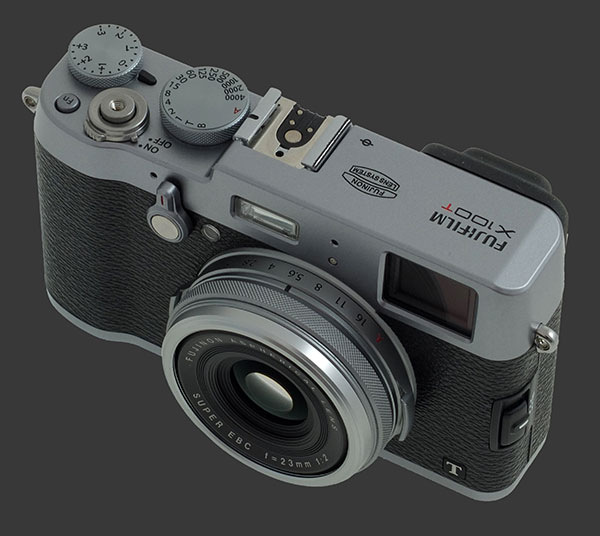
Dynamic-range is superb, although one can easily notice that Fuji uses an entirely different approach. Maximum dynamic-range is achievable between 800 and 6400 where it is above that of most digital cameras. At ISO 400, the dynamic-range is still impressive and at ISO 200 it is comparable to other APS-C cameras. ISO 100, being a simulated sensitivity, clips highlights noticeably more, so there is little reason to use this sensitivity, particularly when considering the X100T has a built-in 3-stop ND-filter.
Rendition of JPEG images is highly influenced by image parameters. For best results, set Sharpness to +1 and use Pro Negative Standard with Noise Reduction at -2. Sharpness settings are gentle and parameter steps are fine, so there is limited latitude besides changing Film Simulation mode.
The Fujinon 23mm F/2 lens is a superb achievement. It is perfectly sharp from F/2 except at the extreme corners of images. Corners get noticeably sharper at each stop down from the maximum with the sweet-spot around F/5.6. There is no noticeable distortion or vignetting either. Purple fringing is a rarely for this lens, appearing only when shooting directly towards strong light sources.
Automatic while-balance is good but not perfect. In typical outdoor conditions, it generally does very well. In the presence of artificial light, mostly tungsten, it leaves a noticeable yellowish cast. Switching to a white-balance preset corrects this in most situations. Custom white-balance works as expected.
Metering is surprisingly reliable, mostly because the preview is not always Exposure-Priority and highlight burn out faster in the EVF/LCD than reality, so the camera can trick the user into under-exposing. This digital camera copes well and generally avoids over-exposure except for particularly dark scenes. Under-exposure is extremely rare. There is a Live-Histogram which shows metered exposure and it is even available in OVF mode.
The speed of Fuji X100T is relatively good, particularly when it comes to autofocus. The hybrid Phase-Detect and Contrast-Detect system works very well and is capable of locking focus quickly. It does so when light is good. In low-light though, it slows down considerably. The camera can focus in less than ¼s but can take up to 1s or so.
The performance of the Fuji X100T is characterized by the following numbers:
- Power On: 1½s, good.
- Power to first shot: 2½s, average.
- Autofocus: ¼s to 1s. Very good in moderate light. Better than average for a fixed-lens camera in low-light.
- Shutter-Lag: Instant with ½s black-out. Good for a fixed-lens camera.
- Shot-to-shot: Just under 1s, average.
- Playback: Just above 1s to enter or exit. Average.
- Power-Off: 1s, good.
While surprisingly a little slower than its predecessor, these numbers are good and compare well to other fixed lens cameras. However, they lag behind DSLRs and high-end mirrorless cameras which around the price of the X100T.
Continuous shooting offers both 6 and 3 FPS. The buffer accommodates up to 30 JPEG files which is a 5 second burst. RAW files are much heavier with only room for 8. A fast memory-card makes a notable difference when waiting for the write to finish. One feature that is exceptionally fast is Motion Panorama which shows the results immediately after completing the pan. Bracketing is speedy too. AEB and Dynamic-Range bracketing are performed as real brackets but ISO and FSB are both performed virtually, so one shot is taken but it is saved three times with different settings. Surprisingly this includes ISO.
Battery life is quoted at 330 shots according to the CIPA standard which requires 50% flash use. This is below average for a modern camera. Given the camera's exceptional ISO performance though, you can easily stretch this by using the flash less often.
Fujifilm X100T Conclusion
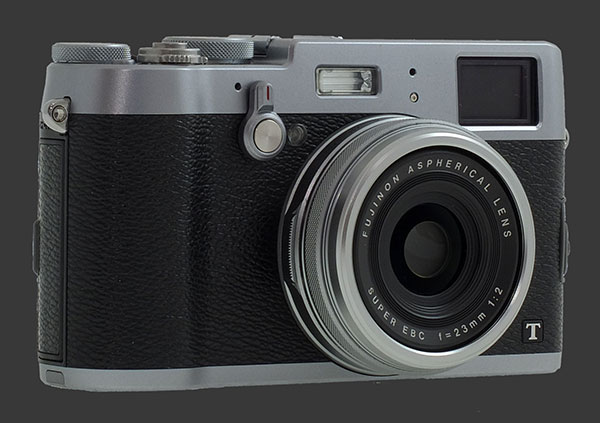
The Fuji X100T produces superb image-quality, matching that of DSLRs and fixed-lens cameras which APS-C sensors. Noise levels are extremely low and fine-details are rendered well up to maximum standard ISO. The lack of an anti-alias filter lets it capture plenty of details with critical sharpness.
This camera delivers great dynamic-range, good exposure, pleasing color and generally accurate white-balance. The lens is exceptionally sharp with virtually no distortion or sign of vignetting. High ISO performance is clearly impressive, although the new processing engine eats up a little more details than before. This is only an issue for JPEG images, since RAW files can be processed with an entirely different algorithm.
Having access to such an excellent performance in a compact camera, is probably reason enough to want one and overlook its share of oddities. Despite an analog design and having plenty of external controls, ergonomics of the X100T are far from perfect. Still, one gets used to some of those quirks after a while. The unique built-in hybrid viewfinder allows for a greater sense of closeness to the scene. Its 2.4 megapixels EVF mode is superb and pleasant to use.
The speed of the Fuji X100T is good overall. Autofocus though is particular fast in good to moderate light. It slows down considerably when light levels drop but still surpassed most fixed lens cameras. The continuous drive is fast and the camera clears the buffer extremely quickly when used with a high-speed memory card.
There are reasons for passing on the X100T, even if you can afford one. The obvious one is the fixed 23mm lens. If it does not fit the bill, it just does not. The second is competition, for the price of this camera, one can get a much more flexible mirrorless camera, including one or more lenses. The Fujifilm X-E2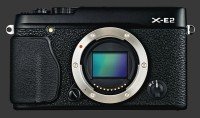
Fujifilm X-E2, which uses a very similar sensor, goes for less, including either a zoom or prime lens. It also features a 2.4 MP EVF.
The Fuji X100T proves to be an excellent yet pricey camera. Its unique technologies like the X-Trans II CMOS sensor and hybrid viewfinder may just be what some are looking for. Its bright F/2 prime lens with built-in leaf-shutter also delivers top-notch image-quality in this size. The X100T shows great appeal and can satisfy those who are comfortable with the constraints of a single prime lens.
 |
Please Support Neocamera
All information on Neocamera is provided free of charge yet running this website is a huge endeavor. Purchases made via affiliate links found throughout the site help keep it running and up-to-date. There is no additional cost to you, so please consider buying via these links to our affilates:
If you found any information on this site valuable and did not purchase via our affiliate links, please considering donating via PayPal:
Any amount will be greatly appreaciated. Thank you for your support!
Fujifilm X100T Highlights
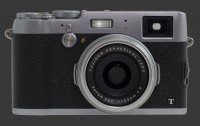
Sensor-Size: 24 x 16mm

Actual size when viewed at 100 DPI
| 16 Megapixels Fixed Lens | ISO 100-51200 |
| Fixed 35mm lens | Shutter 1/32000-30s |
| 0.48" Hybrid EVF 2.4 Megapixels (0.65X) | Full manual controls, including Manual Focus |
| Automatic Eye-Start sensor | Custom white-balance with 2 axis fine-tuning |
| 1 Axis Digital Level | Spot-Metering |
| 6 FPS Drive, 25 Images | Hot-Shoe |
| 1920x1080 @ 60 FPS Video Recording | Stereo audio input |
| 3" LCD 1 Megapixels | Lithium-Ion Battery |
| Secure Digital Extended Capacity |
Updates
2025.01.18

Fujifilm GFX 2025 Lens Roundup
Lens Review roundup of Fujifilm GFX Medium-Format lenses. Quality, performance and handling of the GF20-35mm F/4R WR, GF30mm F/3.5 Tilt-Shift and the GF55mm F/1.7.
2024.11.18

Best 2024 Photography Gifts for Every Budget
Great gifts for photographers and photo enthusiasts selected for every budget among the best products of 2024.
2024.08.07

Eye Protection Tips for Professional Photographers
The four main considerations for professional photographers regarding eyewear.
2024.07.14

Fujifilm X100VI Review
Flagship fixed-lens compact digital camera with a 40 MP sensor and Image-Stabilization, a first for the series. Retro design featuring dual control-dials, plus direct ISO, Shutter-Speed and EC dials. Its hybrid viewfinder can switch between EVF and OVF mode.
2024.05.09

Fujifilm GFX100 II Review
Flagship 102 Megapixels Medium-Format Mirrorless Digital Camera with 8-Stop 5-Axis IBIS, 8 FPS Drive, 8K Video and 400 MP Super-Resolution capture in a weatherproof and freezeproof body with dual control-dials and dual memory-card slots.
2024.04.03

Fujifilm X-T5 Review
Newest Fujifilm flagship boasting a 40 MP APS-C sensor, 5-axis IBIS with 7-stop efficiency, 15 FPS continuous drive, 6.2K Video capture, dual control-dials and dual SDXC UHS-II slots in a sturdy weatherproof and freezeproof body.
2023.11.20

Best Digital Cameras of 2023
Find out which are the Best Digital Cameras of 2023. All the new Mirrorless Digital Cameras from entry-level to high-end professional.
2023.07.10

Fujifilm X-H2 Review
40 Megapixels APS-C Hybrid Mirrorless Digital Camera with 7-stop IBIS. Fastest shutter ever and 8K video capture. Large builtin EVF with 0.8X magnification and 5.8 MP, plus an Eye-Start Sensor. Packed with features and large number of controls in a weatherproof and freezeproof body.
2023.05.07

Sony FE 20-70mm F/4G Review
Review of the unique Sony FE 20-70mm F/4G lens. The optical zoom of this lens spans ultra-wide-angle and medium focal-length coverage, making it one of the most versatile Full-Frame lenses on the market.
2023.01.15

Huion Inspiroy Dial 2 Review
Review of the Huion Inspiroy Dial 2 tablet, a medium sized drawing surface with dual dials and customizable buttons. Connects via USB-C or Bluetooth 5.0 with Windows, Linux and Android support.
2022.12.08

How to Pack for a Photo Trip
Find out how to pack for a travel photography trip, carry your gear safely while meeting airline regulations.
2022.11.13

Best Digital Cameras of 2022
The best digital cameras of 2022. A short list of the most outstanding models in their respective categories. Choose one for yourself or as a gift.















